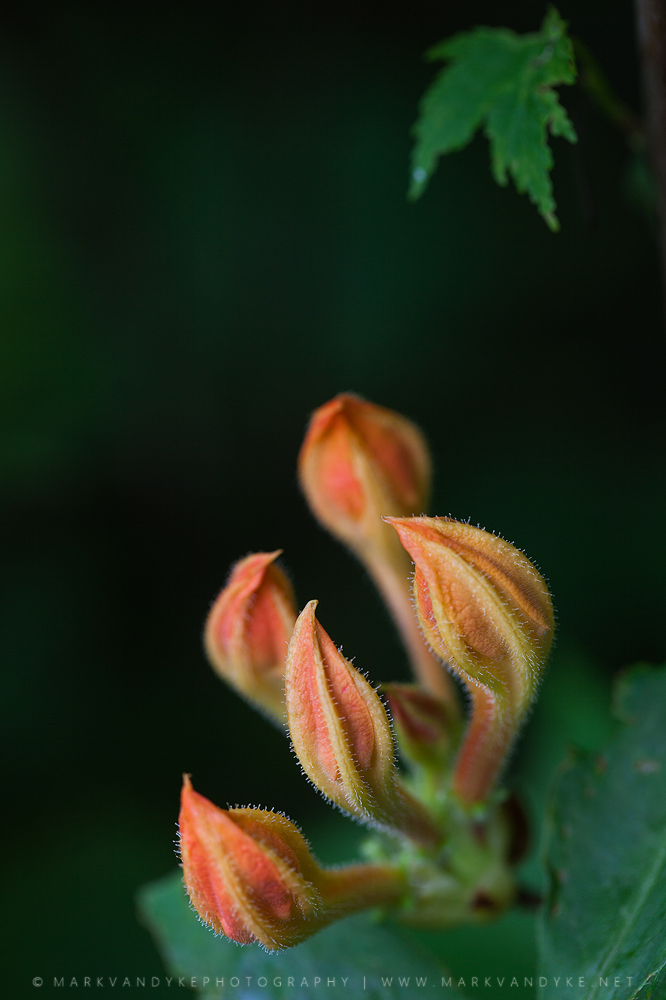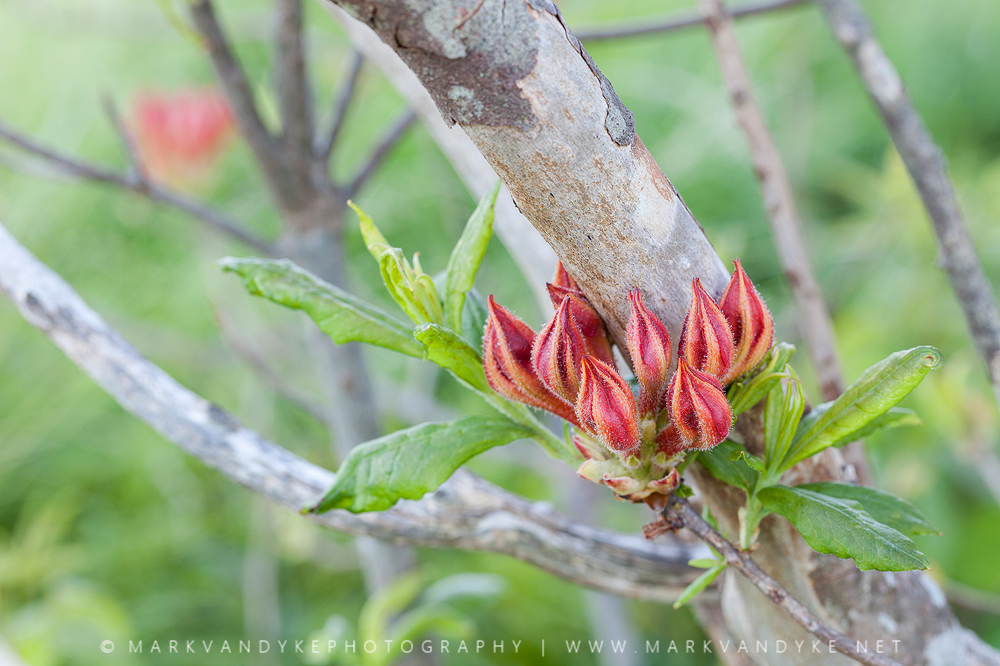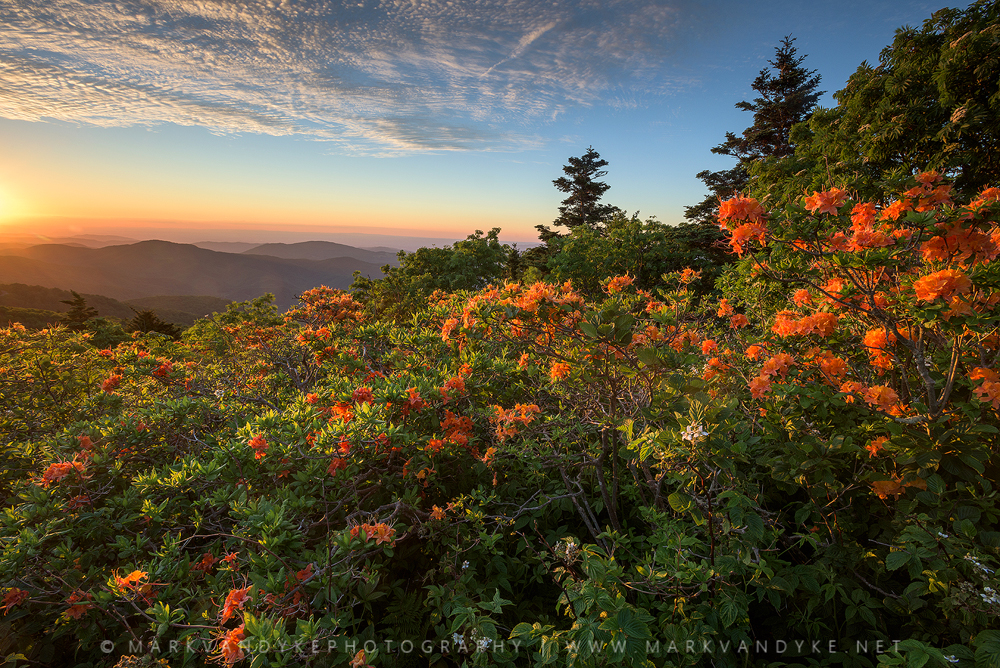
Photo Essay: Pinkshell & Flame Azalea 2016
In March 2016, while I was photographing the annual spring bloom in the Lowcountry of South Carolina, Our State Magazine–a North Carolina periodical–reached out to me and offered an opportunity to complete an assignment to be featured in the April 2017 issue: locate and photograph Pinkshell Azalea (R. vaseyi) and Flame Azalea (R. calendulaceum) in the North Carolina mountains.
The overall assignment was multi-part with other photographers simultaneously combing the state from mountains to coast in search of azalea. My responsibilities were two-fold: First, create imagery of R. vaseyi from the southern Blue Ridge Parkway, an area often mentioned in literature as the epicenter of wild Pinkshell Azalea, a species native to only North Carolina and confined to two small regions within the mountains. Second, I was to return to Western North Carolina a month or two later to locate and photograph the exuberant orange flowering Flame Azalea.
PINKSHELL AZALEA
Much like ephemeral ground flowers, Pinkshell Azalea (Rhododendron vaseyi) put on a show of color and energy long before the leaf canopy above suffocates ample spring sunshine. Towards the last week in April each spring, Pinkshell Azalea put on a rare show within a landscape still largely within the grips of winter. Pale pink to deep rose, large buds and showy flowers begin to light steep hillsides and open boundary areas along the Blue Ridge Parkway. Authors Hyatt & McLellan describe the experience of R. vaseyi as similar to “watching myriads of dancing pink butterflies animated by the cool mountain breezes.”
Discovered in 1879 by George Vasey and named as a new species by Asa Gray in 1879, R. Vaseyi is endemic to North Carolina. Wild Pinkshell Azalea can only be found in two regions of the Southern Appalachian Mountains, their range rather limited. Occurring from about 3000 to 5500 feet in elevation, R. Vaseyi can be found around the (1) Grandfather Mountain / Linville Gorge areas and/or the (2) Southern Blue Ridge Parkway around Beech Gap and Graveyard Fields (milepost 419 to 425). The flowering shrubs will be hard to miss, growing along the roadway, on steep slopes underneath deciduous trees and up on exposed rocky cliff faces.
“… like watching myriads of dancing pink butterflies animated by the cool mountain breezes.”
Donald W. Hyatt and George K. McLellan
FLAME AZALEA
If you like your flowers vibrant, it’s hard to imagine a more emboldened species than the fiery orange and yellow coloring of Rhododendron calendulaceum, known commonly as Flame Azalea. Flame Azalea are native to the Southern Appalachian Mountains of North Carolina. Their range, however, is far more extensive than the Pinkshell Azalea above, occurring at various elevations from Pennsylvania to Georgia. A member of the heath family, flowering Flame Azalea don colors from orange/red to buttery yellow and every combination therein, sometimes showing variability on the same shrub! The most common color is orange. Flame Azalea have clusters of five to fifteen buds and flower to a diameter of around two inches around five lobes.
Wild Flame Azalea have a character that is unmistakably bold, unkempt, and rambunctious. Add in unimaginably bright and attention-grabbing orange coloring and it’s hard not to admire these flowering shrubs for their exuberance. Whether underneath a canopy of deciduous trees or high atop an open, grassy bald, you will not mistake or fail to notice the Flame Azalea. While traveling through the Carolinas in 1791, William Bartram wrote that Flame Azalea are “…certainly the most gay and brilliant flowering shrub yet known.” The Roan Highlands offer a premier venue for viewing the annual spring bloom of Flame Azalea, with several thick stands of various colorings flowering along the Appalachian Trail atop open, grassy meadows with layered mountain views of North Carolina as a backdrop.
“… certainly the most gay and brilliant flowering shrub yet known.”
William Bartram, 1791
THOUGHTS & LESSONS LEARNED:
This was my first opportunity to perform assignment work for a publication. Typically I shoot speculatively: I choose the time, place and subject based on my own intuition and research, I front all associated costs with travel and capture, and then I present the finished files to market through a number of different channels. The process suffers a considerable lag between the idea/capture and the commercial uptake. For me, it often takes a considerable amount of activity to get the finished file and idea out into the universe where it can be seen by the appropriate photo editors and photo buyers (this is why all the fuss about social media and SEO–quickly reaching a high number of the right eye balls is critical). Depending on the seasonality of the image, the window of use can be further limited. Most of the time, I figure I’m creating images today that will find the market one- to two-years out.
Assignment work is a new beast for me. The photo buyer is predetermined and the purpose is clear and stated upfront. While there’s creative flexibility within the concept, the idea has already been formed and simply needs execution. From that stance, there’s less creative work involved by me upfront in terms of selecting subject/time/place etc. but greater accountability on the backend in terms of meeting agreed-upon expectations and quotas. New worries emerge with assignment work: my gear cannot fail me and I can’t just shrug off a miss and say that I’ll get it next year. Things like gear redundancy and a willingness to engage less than perfect conditions are much more of the operational norm with assignment work. The emphasis of capture shifts as well, from one incredibly perfect image (fine art) to a collection of meaningful story-telling images shot to a pre-determined standard.
Did I enjoy assignment work? Strangely, I did! I thought that the increased pressure to deliver quantity during what was more than likely going to be a string of less-than-perfect weather days would be de-motivating and dissatisfying. I’ve always had the creative freedom to not force what wasn’t there and to switch subjects at will depending upon environmental conditions and personal interests. I thought that assignment work would feel rather restrictive in comparison. However, I found some of the realities of assignment work liberating. I no longer had to be responsive to the weather, constantly worrying, checking and planning around whether it was going to be rainy or windy or cloudy etc.: I was commissioned to capture azalea at a specific location and time of year and it didn’t matter what the weather was or wasn’t going to be, I was going to be there taking photos! That freedom allowed me to spend more time with the subject, getting to know its tendencies in various environmental conditions and during different times of day. In effect, assignment work functioned to organize and limit the world for me, providing a degree of focus for my creativity and efforts that was actually very pleasing. And of course, I would be remiss if I didn’t admit that the thought of someone looking at and evaluating my photography (other than just me) was kind of motivating as well.
Were my efforts a success or failure? That’s a really difficult question to address. The magazine was happy with the collection of images I presented and three were chosen for publication, a seeming confirmation or validation of the efforts if you will. Further, I was engaged to perform additional assignment work for the magazine later in the calendar year, again, seeming validation that I provided a service that was worth their investment.
Could I have done better as the photographer? Yes. Without a doubt. I missed some shots and I left others on the table–incomplete ideas unrealized on my memory cards. I still have a vision of the photographer I want to be versus the photographer that I am. Working to bridge that chasm is an ongoing effort. From a business perspective, I didn’t honor the cost / benefit ratio either: I was terribly inefficient financially. I spent over a month on the ground in the field capturing the two bloom events. Expenses for food, gas, camping, gear etc. far outweighed the monies coming in. I didn’t splurge on lodging, expensive meals or anything of that nature, I simply spent too much time trying to get it “right.”
I don’t have varying levels of effort based on dollar amounts offered. I’m all-in if I say yes. I’ll travel as far as it takes, walk as many miles as necessary, brave whatever weather I encounter, and return again and again until it makes no sense to do it again. If I accept an assignment, I’ll do whatever I can to deliver the best product that I’m capable of. This was my first opportunity to work with Our State through assignment and as such, I’m not so much bothered by the fact that I overspent my budget. However, moving forward, I must learn to be more efficient and effective with my time and resources, and more importantly, to only say “yes” to assignment work that allows me to go “all-in” and not take a loss.
A huge thanks to the folks over at Our State Magazine for this opportunity. The degree of creative freedom offered was awesome and the fact that you chose me to carry forth your vision (when many others were available) was not unnoticed nor unappreciated. Thank you!

Interested in subscribing?
I look forward to receiving my copy each month!





















Fantastic Mark! Those are a wonderful photos!
Thanks, Jim! I had a great time working the mountains this past spring. I usually never spend much time with the Pink Shells so it was neat to give a week to them and learn some new things!
Such a great read Mark! The time you take to put into these essay’s is indeed appreciated. You secured a great crop of images for sure my friend. Your shot used for ‘An Abundance of Azaleas’ is a spectacular image and it’s no surprise it was selected for print. Keep up the inspiration buddy.
Hey Chad! Thanks, man! The crop of azalea between Jane’s Bald and the spur trail to Grassy is a wonderful spot to take in a sunset. It faces west and the coloring is such a great compliment to sunset. I was hoping for big skies and calm winds, but that’s a big ask up at Roan :-). It was a fun assignment and I’m glad that I took it. I hope to get a few more similar opportunities in the future. Hope you’re doing great, bud!